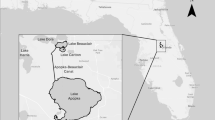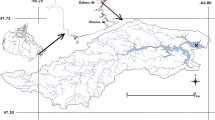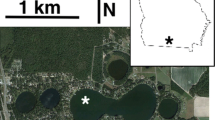Abstract
The northern Everglades Water Conservation Areas have experienced recent ecological shifts in primary producer community structure involving marl periphyton mats and dense Typha-dominated macrophyte stands. Multiple investigations have identified phosphorus (P) as a driver of primary producer community structure, but effects of water impoundment beginning in the 1950s and changes in water hardness [e.g., (CaCO3)] have also been identified as a concern. In an effort to understand pre-1950, primary producer community structure and identify community shifts since 1950, we measured pigment proxies on three sediment cores collected in Water Conservation Area-2A (WCA-2A) along a phosphorus enrichment gradient. Photosynthetic pigments, sediment total phosphorus content (TP), organic matter, total organic carbon and nitrogen were used to infer historic primary producer communities and changes in water quality and hydrology regulating those communities. Excess 210Pb was used to establish historic dates for the sediment cores. Results indicate the northern area of WCA-2A increased marl deposition and increased algal abundance ca. 1920. This increase in (presumably) calcareous periphyton before intensive agriculture and impoundment suggest canal-derived calcium inputs and to some extent early drainage effects played a role in initiating this community shift. The northern area community then shifted to Typha dominance around 1965. The areas to the south in WCA-2A experienced increased marl deposition and algal abundance around or just prior to 1950s impoundment, the precise timing limited by core age resolution. Continued increases in algal abundance were evident after 1950, coinciding with impoundment and deepening of canals draining into WCA-2A, both likely increasing water mineral and nutrient concentrations. The intermediate site developed a Typha-dominated community ca. 1995 while the southern-most core site WCA-2A has yet to develop Typha dominance. Numerous studies link sediment TP >650 mg P/kg to marsh habitat degradation into Typha-dominance. The northern and intermediate cores where Typha is currently support this previous research by showing a distinct shift in the sediment record to Typha dominance corresponding to sediment TP between 600 and 700 mg P/kg. These temporal and spatial differences are consistent with modern evidence showing water-column gradients in mineral inputs (including Ca, carbonates, and phosphorus) altering primary producer community structure in WCA-2A, but also suggest hydroperiod has an effect on the mechanisms regulating periphyton development and Typha dominance.









Similar content being viewed by others
References
Appleby PG (2001) Chronostratigraphic techniques in recent sediments. In: Last WM, Smol JP (eds) Tracing environmental changes using lake sediments, vol 1. Kluwer, Boston, pp 171–203
Browder JA, Gleason PJ, Swift DR (1994) Periphyton in the Everglades: spatial variation, environmental correlates, and ecological implications. In: Davis SM, Ogden JC (eds) Everglades: the ecosystem and its restoration. St. Lucie Press, Delray Beach, pp 379–418
Cohen AD, Gage CP, Moore WS (1999) Combining organic petrography and palynology to assess anthropogenic impacts on peatlands—part 1. An example from the northern Everglades of Florida. Int J Coal Geol 39:3–45
Davis SM (1994) Phosphorus inputs and vegetation sensitivity in the Everglades. In: Davis SM, Ogden JC (eds) Everglades: the ecosystem and its restoration. St. Lucie Press, Delray Beach, pp 357–378
Dodds WK (2003) The role of periphyton in phosphorus retention in shallow freshwater aquatic systems. J Phycol 39:840–849
Gaiser EE, Scinto LJ, Richards JH, Jayachandran K, Childers DL, Trexler JC, Jones RK (2004) Phosphorus in periphyton mats provide the best metric for detecting low-level P enrichment in an oligotrophic wetland. Water Res 38:507–516
Gaiser EE, Trexler JC, Richards JH, Childers DL, Lee D, Edwards AL, Scinto LJ, Jayachandran K, Noe GB, Jones RD (2005) Cascading ecological effects of low-level phosphorus enrichment in the Florida Everglades. J Environ Qual 34:717–723
Gleason PJ, Spackman W (1974) Calcareous periphyton and water chemistry in the Everglades. In: Gleason PJ (ed) Environments of South Florida: present and past II. Miami Geological Society, Coral Gables, pp 146–181
Gunderson LH (2001) Managing surprising ecosystems in southern Florida. Ecol Econ 37:371–378
Hagerthey SE, Newman S, Rutchey K, Smith EP, Godin J (2008) Multiple regime shifts in a subtropical peatland: community-specific thresholds to eutrophication. Ecol Monogr 78:547–565
Leavitt PR, Hodgson DA (2001) Sedimentary pigments. In: Smol JP, Birks HJP, Last WM (eds) Tracking environmental change using lake sediments, terrestrial, algal, and siliceous indicators, vol 3. Kluwer, Dordrecht, pp 295–325
Leavitt PR, Vinebrooke RD, Donald DB, Smol JP, Schindler DW (1997) Past ultraviolet radiation environments in lakes derived from fossil pigments. Nature 388:457–459
Light SS, Dineen JW (1994) Water control in the Everglades: a historical perspective. In: Davis SM, Ogden JC (eds) Everglades: the ecosystem and its restoration. St. Lucie Press, Delray Beach, pp 47–84
McCormick PV, O’Dell MB (1996) Quantifying periphyton responses to phosphorus in the Florida Everglades: a synoptic-experimental approach. J North Am Benthol Soc 15(4):450–468
McCormick PV, Rawlik PS, Lurding K, Smith EP, Sklar FH (1996) Periphyton-water quality relationships along a nutrient gradient in the northern Florida Everglades. J North Am Benthol Soc 15(4):433–449
McCormick PV, Shuford RBE, Backus JG, Kennedy WC (1998) Spatial and seasonal patterns of periphyton biomass and productivity in the northern Everglades, Florida, USA. Hydrobiologia 362:185–208
McCormick PV, O’dell MB, Shuford RBE, Backus JG, Kennedy WC (2001) Periphyton responses to experimental phosphorus enrichment in a subtropical wetland. Aquat Bot 71:119–139
McCormick PV, Newman S, Miao S, Gawlik DE, Marley D, Reddy KR, Fontaine TD (2002) Effects of anthropogenic phosphorus inputs on the Everglades. In: Porter JW, Porter KG (eds) The Everglades, Florida Bay and coral reefs of the Florida keys. CRC Press, Boca Raton, pp 83–126
McCormick PV, Shuford RBE, Chimney MJ (2006) Periphyton as a potential phosphorus sink in the Everglades nutrient removal project. Ecol Engin 27:279–289
Meyers PA, Teranes JL (2001) Sediment organic matter. In: Smol JP, Birks HJP, Last WM (eds) Tracking environmental change using lake sediments, terrestrial, algal, and siliceous indicators, vol 2. Kluwer, Dordrecht, pp 239–269
Moore WS (1984) Radium isotope measurements using germanium detectors. Nucl Inst Methods 223:407–411
Newman S, Grace JB, Koebel JW (1996) Effects of nutrients and hydroperiod on typha, cladium, and eleocharis: implications for Everglades restoration. Ecol Appl 6:774–783
Noe GB, Childers DL, Jones RD (2001) Phosphorus biogeochemistry and the impact of phosphorus enrichment: why is the Everglades so unique? Ecosystems 4:603–624
Noe GB, Childers DL, Edwards AL, Gaiser EE, Jayachandran K, Lee D, Meeder J, Richards J, Scinto LJ, Trexler JC, Jones RD (2002) Short-term changes in phosphorus storage in an oligotrophic Everglades wetland ecosystem receiving experimental nutrient enrichment. Biogeochemistry 59:239–267
Reynolds CS (2006) The ecology of phytoplankton. Cambridge University Press, Cambridge
Ross MS, Reed DL, Sah JP, Ruiz PL, Lewin MT (2003) Vegetation:environment relationships and water management in Shark Slough, Everglades National Park. Wet Ecol Manag 11:291–303
Rutchey K, Schall T, Sklar F (2008) Development of vegetation maps for assessing Everglades restoration progress. Wetlands 28:806–816
Schelske CL, Lowe EF, Battoe LE, Brenner M, Coveney MF, Kenney WF (2005) Abrupt biological response to hydrologic and land-use changes in Lake Apopka, Florida, USA. Ambio 34:192–198
Scinto LJ, Reddy KR (2003) Biotic and abiotic uptake of phosphorus by periphyton in a subtropical freshwater wetland. Aquat Bot 77:203–222
Slate JE, Stevenson RJ (2000) Recent and abrupt environmental change in the Florida everglades indicated from siliceous microfossils. Wetlands 20:346–356
Snyder GH, Davidson JM (1994) Everglades agriculture: past, present, and future. In: Davis SM, Ogden JC (eds) Everglades: the ecosystem and its restoration. St. Lucie Press, Delray Beach, pp 85–115
Urban NH, Davis SM, Aumen NG (1993) Fluctuations in sawgrass and cattail densities in Everglades water conservation area 2A under varying nutrient, hydrologic and fire regimes. Aquat Bot 46:203–223
US Army Corps of Engineers (1999) Central and Southern Florida comprehensive review study. Final integrated feasibility report and programmatic environmental impact statement. United States Army Corps of Engineers, Jacksonville
Vaithiyanathan P, Richardson CJ (1997) Nutrient profiles in the Everglades: examination along the eutrophication gradient. Sci Total Environ 205:81–95
Waters MN, Piehler MF, Smoak JM, Martens CS (2010) The development and persistence of alternative ecosystem states in a large, shallow lake. Freshw Biol 55:1249–1261
Willard DA, Holmes CW, Weimer LW (2001). The Florida Everglades ecosystem: climatic and anthropogenic impacts over the last two millennia. In: Wardlaw BR (ed) Bulletins of American Paleontology, vol 361, pp 41–55
Wu Y, Sklar FH, Rutchey K (1997) Analysis and simulations of fragmentation patterns in the Everglades. Ecol Appl 7:268–276
Wu Y, Wang N, Rutchey K (2006) An analysis of spatial complexity of ridge and slough patterns in the Everglades ecosystem. Ecol Complex 3:183–192
Acknowledgments
This research was funded by the South Florida Water Management District. Phosphorus was analyzed at the University of Florida Land Use and Environmental Change Institute (LUECI) with the help of William Kenney. Organic carbon and nitrogen were analyzed at Florida State University, National High Magnetic Field Laboratory by Drs. Xu and Wang. Christian Sanders assisted with core collection, and Biliana Ivanova assisted with core collection, core sectioning, sample preparations and 210Pb analysis. This material is also based upon work supported by the National Science Foundation-funded FCE-LTER program under Grant No. DEB-9910514.
Author information
Authors and Affiliations
Corresponding author
Electronic supplementary material
Below is the link to the electronic supplementary material.
10933_2011_9569_MOESM1_ESM.tif
ESM Figure 1. Timeline of key changes in primary producer communities (a) demonstrated in previous (top panels) and current (bottom) paleoecological studies in WCA-2A. Gray shaded areas represent the time domain captured in each study. Timeline of qualitative changes in hydrology (b) based on historic records and paleoecological studies. Timeline of changes in sugarcane production (hectares) in the Everglades Agricultural Area (c). References are indicated in parentheses: (1) Cohen et al. 1999; (2) Willard et al. 2001; (3) Slate and Stevenson 2000); (4) Light and Dineen 1994; (5) Rutchey et al. 2008; and (6) Snyder and Davidson 1994. Supplementary material 1 (TIFF 1520 kb)
Rights and permissions
About this article
Cite this article
Waters, M.N., Smoak, J.M. & Saunders, C.J. Historic primary producer communities linked to water quality and hydrologic changes in the northern Everglades. J Paleolimnol 49, 67–81 (2013). https://doi.org/10.1007/s10933-011-9569-y
Received:
Accepted:
Published:
Issue Date:
DOI: https://doi.org/10.1007/s10933-011-9569-y




